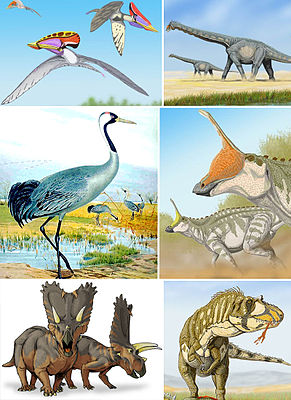Ornithodira
| Ornithodira | ||||||||||
|---|---|---|---|---|---|---|---|---|---|---|

Various members of the Ornithodira, clockwise from top left: Tupuxuara , Alamosaurus , Tsintaosaurus , Daspletosaurus , Pentaceratops , crane ( Grus grus ). |
||||||||||
| Temporal occurrence | ||||||||||
| Upper Triassic to Holocene | ||||||||||
| 220 to 0 million years | ||||||||||
| Locations | ||||||||||
|
||||||||||
| Systematics | ||||||||||
|
||||||||||
| Scientific name | ||||||||||
| Ornithodira | ||||||||||
| Gauthier , 1986 |
The ornithodira are a large group of archosaurs . It is a so-called node-based taxon which is defined as the clade the last common ancestor of the Flugsaurier (Pterosauria) and dinosaurs and all its descendants (and thus also the birds comprises).
Etymology and Concept
The name Ornithodira is composed of the Greek prefix ὀρνιθο- ( ornitho- ) for terms related to birds and the word δειρή ( deire ) for "neck". It refers to a characteristic feature of this group, the S-shaped curved cervical spine, as it is still typical for birds today, and was coined by Jacques Gauthier in 1986.
features
The combination of pterosaurs, dinosaurs and a few other taxa in a common group is based on the S-shaped curved cervical spine, the typical structure of the ankle, with the joint between the "upper" (proximal) tarsus astragalus , which is closer to the knee joint and calcaneus and the "lower", closer to the tip of the foot (distal) tarsal bone (tarsalia distalia). One speaks here of a mesotarsal joint (joint in the "middle" of the tarsus). This arrangement in connection with elongated toe bones allows the animals a digitigrade locomotion, i.e. walking on their toes. The Ornithodira are compared to their sister group Crurotarsi , consisting of some extinct taxa such as the Phytosauria and the more recent crocodiles , in which the ankle lies between astragalus and calcaneus, which allows their representatives to appear with the entire sole of the foot. With the exception of a few groups of dinosaurs, the Ornithodira do not have any bone platelets embedded in the dorsal skin (so-called dorsal osteoderms), which are typical of crurotarsians and today's crocodiles.
Systematics
Since the genus Scleromochlus , which was considered the basal representative of the pterosaurs in the past, is outside of the ornithodira according to recent analyzes, the ornithodira are now not the sister taxon of the Crurotarsi, but the sister taxon of Scleromochlus .
-
Archosauria (Archosaur Crown Group, Avesuchia)
- Crurotarsi
-
Avemetatarsalia
- Scleromochlus †
-
Ornithodira
- Flugsaurier (Pterosauria) †
-
Dinosauromorpha
- Storage peton †
-
Dinosauriformes
- Marasuchus †
- Asilisaurus †
-
Dinosaur (dinosauria)
- Birds (aves, avialae)
literature
- Michael J. Benton : Origin and relationships of Dinosauria. In: David B. Weishampel, Peter Dodson, Halszka Osmólska (eds.): The Dinosauria . Second edition. University of California Press, Berkeley 2004, pp. 7-19, ISBN 0-520-24209-2 .